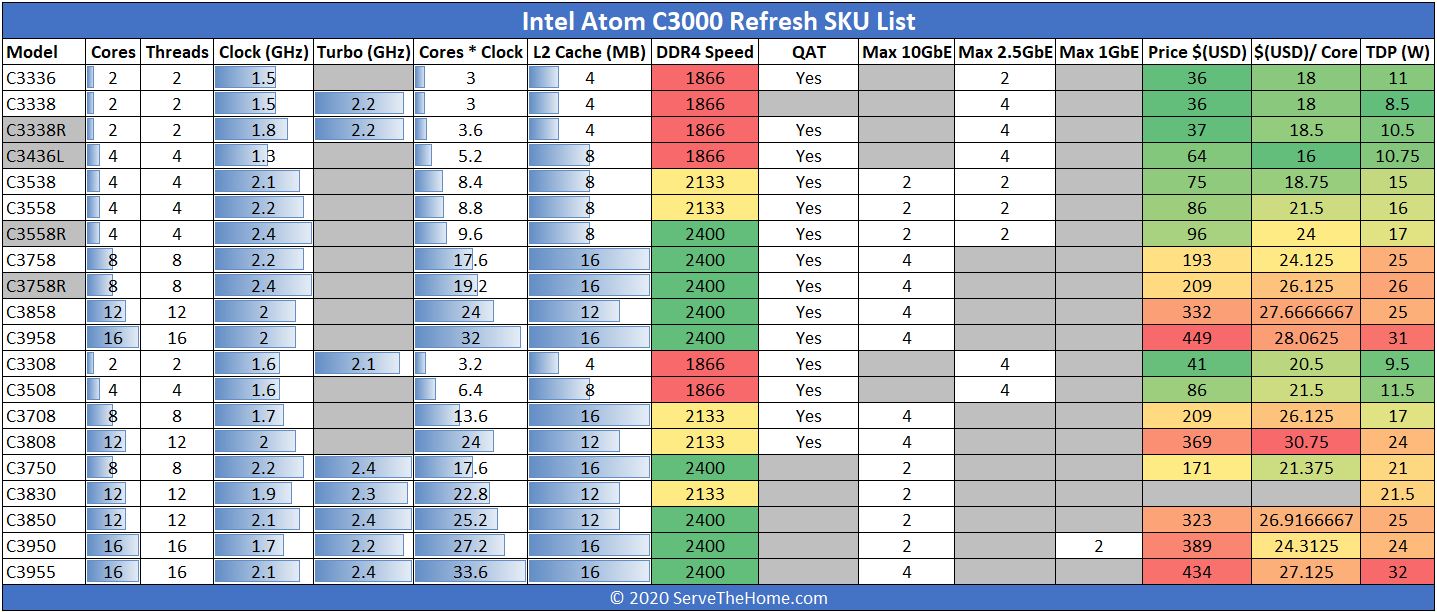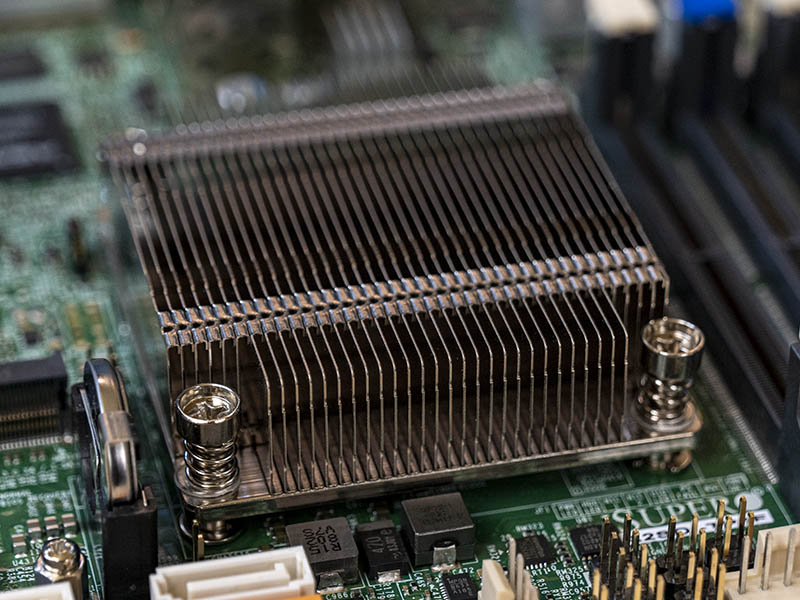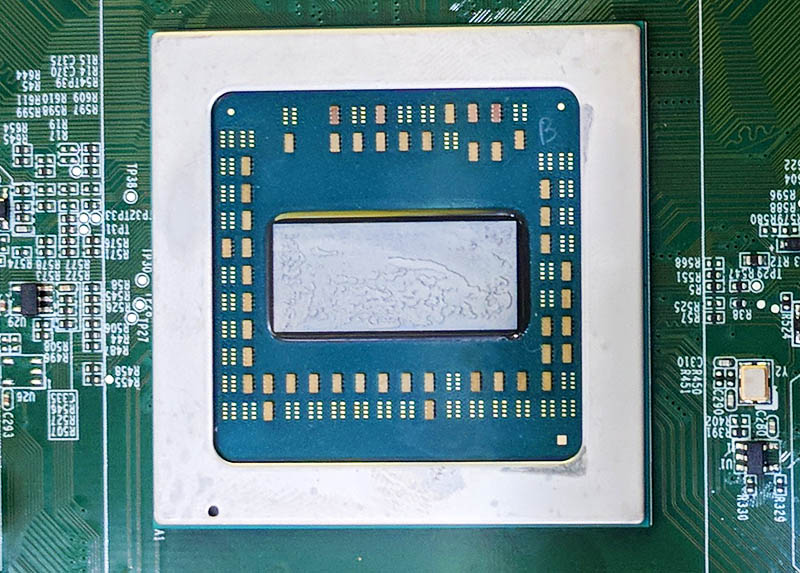Intel Atom C3858 Market Positioning
Thes chips are not released in a vacuum instead, they have competition on both the Intel and AMD sides. When you purchase a server and select a CPU, it is important to see the value of a platform versus its competitors.
Intel Atom C3858 v. Intel Alternatives
Comparing generation on generation, the Intel Atom C3858 is such an enormous improvement over the Atom C2000 series that there is no real competition from the older parts. The generational improvements are simply too great and too widespread. They include more cores (12 v. a maximum of 8), 10GbE support, faster and newer QAT support, PCIe Gen3 support, and the list goes on. As a result, we see the Atom C3858 as a replacement rather than a competitor to the older generation.

With around $120-130 separating this chip and the Atom C3758 as well as the Atom C3958, it occupies a reasonable middle ground. One saves 6W TDP, a big deal in this space, as well as some list price delta for four fewer cores. Compared to the Atom C3758, we get slightly lower clocks and less cache but get more QAT support and more cores. That is a trade-off many will be willing to make. There is also an Atom C3758R which we covered in our Atom C3000 Line Quietly Refreshed piece. Still, with 50% more cores the Atom C3858 sits above those SKUs in the line.

Although one pays more for this SoC, making a $350-400 motherboard and a $332 SOC and we are going to see base 10GbE enabled platforms retail in the $750-850 range for the motherboard and SoC. This may seem like a lot, but it is reasonable for this level of features and performance especially when you compare it to the Xeon E line. Likewise, the Xeon D-2100 and D-1500 lines use more power making them not great alternatives either. This chip is in a fairly unique position until the next-generation arrives.
This is a segment where Intel’s missed transition to 10nm with the Intel Atom P5900 series is important. Intel is betting on high degrees of acceleration with those new parts. As the transition happens, the Atom C3858 will look much like the Atom C2000 does today in terms of being a dated platform. Still, in the embedded space these transitions happen very slowly.
Intel Atom C3858 v. AMD Alternatives
At the time of this writing, the real AMD competition to the Intel Atom C3858 is the AMD Opteron X3421. The AMD Opteron X3421 has the benefit of having higher clock speeds, lower cost, and an integrated GPU. On the other hand, the Intel Atom C3858 offers more performance, is more expandable, has QAT, and uses less power. On balance, if you do not need a GPU the Intel Atom C3858 is better. You can read more about a use case that favors the AMD Opteron X3421 in our HPE ProLiant MicroServer Gen10 Review.

The AMD EPYC 3000 series is a higher TDP SKU that costs more. We do not see these as direct competitors. You can read about that in our AMD EPYC 3251 Benchmarks and Review and even the AMD EPYC 3101 Benchmarks and Review A Lower-End Part.
This is an area that we think AMD will focus on. At the same time, Intel is using a scaled-down core for this space and has a lot of design wins. AMD Zen CPUs tend to have higher-performance cores so they are not directly comparable, especially given the power consumption delta. Still, the EPYC 3000 series may indeed be AMD’s best alternative at the moment.
Intel Atom C3858 v. Arm Competition
This is the segment that is in the clear crosshairs of the Arm Neoverse N1 and E1 cores. Intel, in this generation, has an advantage given the strength of the Atom C2000 series and design wins there. For example, most switches that are publicly available to run open and public SONiC software are x86 based, often using the Atom C3000 series. Likewise, having an x86 firewall or network appliance has been popular.
In terms of the generally available Arm parts, we have yet to see a direct competitor hit the STH lab, but this is an area that the new Marvell OCTEON TX2 and Fusion CNF95xx 5G SoCs and others are squarely targeting for replacement.
Final Words
Overall, there is a lot to like with the Intel Atom C3858. We get 12 high-performance cores, quad 10GbE which is exposed on our test platform, high-memory capacity support, flexible HSIO, all in a 25W SoC. It seems strange, but this 25W SoC is far to powerful compared to many of the NAS units STH reviews. Still, for the 5G Edge, this was a leading Intel product. The future there is likely heavy acceleration. As that transition happens, the Atom C3000 line will likely enjoy success in the workloads that do not need as much acceleration and performance but still benefit from low power and long lifecycles. There the Intel Atom C3858 is well-suited to succeed.




I’ve had an issue twice that needed rma for the sfp+ stopped working. One after another when plugged into a Cisco sg500x switch using DAC cables. I’m now using 10gbase-t with transceivers on the switch side.
A server chip similar to renoir could absolutely rock this segment. AMD currently has to focus on the bigger picture, but no doubt as their market share and margins increase, they will have to compete in this segment as well.
@Thomas – totally agree; Renoir’s performance is stunning for the envelope it operates in. Rome definitely pays a power, cost, and density tax for the I/O and memory bandwidth it offers when it tries to compete at lower core counts.
How doe is compare to i3? What is is power consumption?
As others have already sorta touched on, its a bit sad we have been seeing so much movement in the market with Epyc’s release 3 years ago and yet this is the first major release in the segment in quite a while from Intel because AMD has very little pressure here.
One can only hope– It just stinks having to spend so much money relative to the desktop space to hit these performance numbers in these power envelops.
All this tells me is… Buy the Epyc 3251.
I would greatly appreciate further details regarding the RAM that was used for this test. According to the Supermicro website, only one specific 16 GB ECC SODIMM (at 2666 MHz) has been verified to be compatible, but it’s impossible to get hold of. I have tested two different alternatives from Kingston (dual rank and single rank, both 2666 MHz). None worked (systems doesn’t boot).